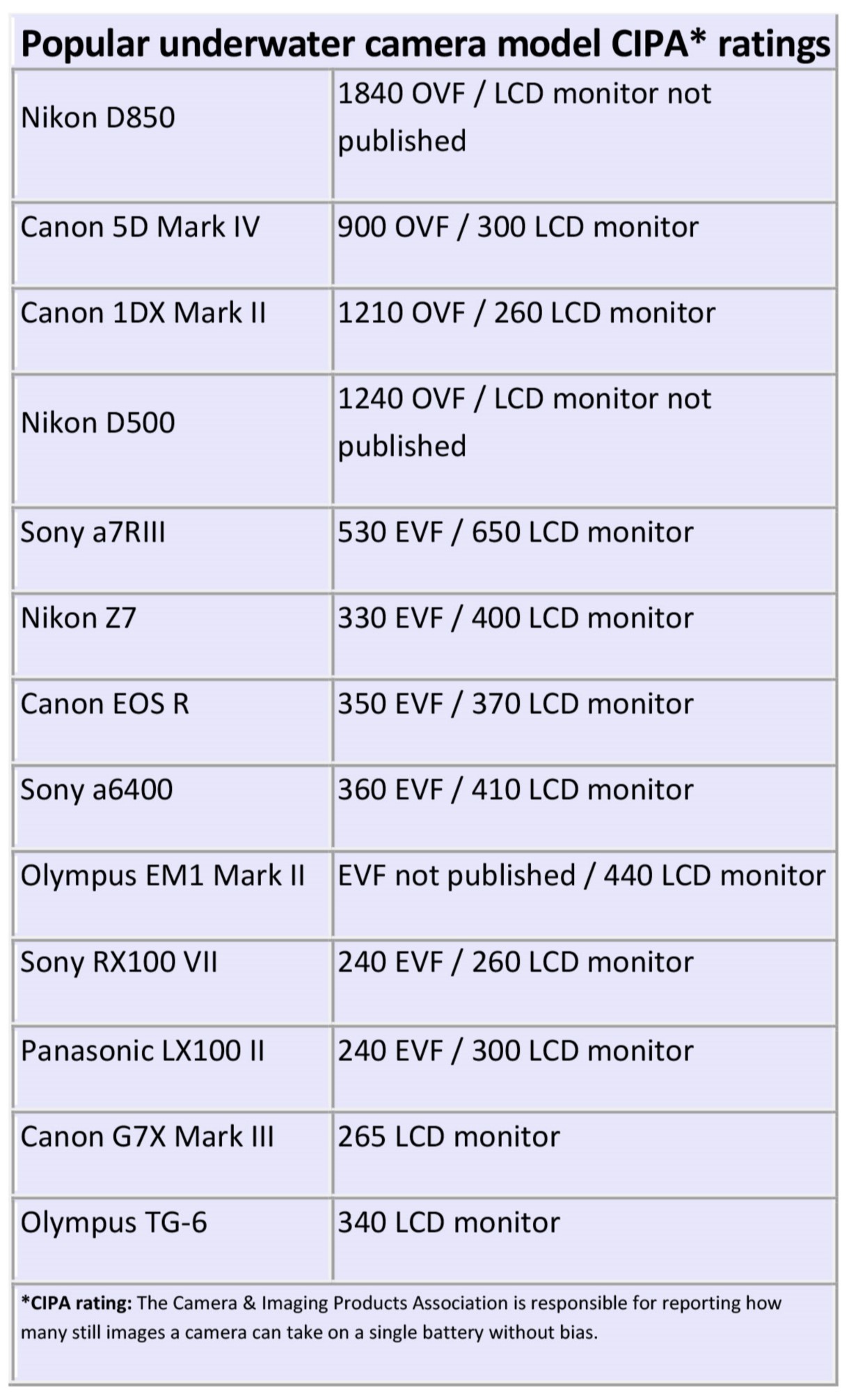![]() At some point or another, underwater photographers are likely to experience a low-battery warning during a dive. Hopefully it occurs towards at the end of the dive, but for those of us unfortunate enough, the warning kicks in early and we end up carrying around a dead camera. Thankfully, there are plenty of ways to improve the camera’s battery life so that dreaded low-battery warning doesn’t ruin your dive.
At some point or another, underwater photographers are likely to experience a low-battery warning during a dive. Hopefully it occurs towards at the end of the dive, but for those of us unfortunate enough, the warning kicks in early and we end up carrying around a dead camera. Thankfully, there are plenty of ways to improve the camera’s battery life so that dreaded low-battery warning doesn’t ruin your dive.
Here are some tips from the Optical Ocean Sales’s team on optimizing and maintaining your camera’s Lithium-ion battery:

1. Use the viewing platform that is optimized for the battery life of your camera.
DSLR’s run down the battery much faster when the LCD monitor is engaged so it is recommended to use the optical viewfinder (OVF) whenever possible. Mirrorless cameras are slightly more efficient using the LCD monitor than the electronic viewfinder (EVF) and most compact cameras only have LCD monitors which eliminates other options.
2. Use power saving modes and options to cut down on battery use whenever possible
When the camera is not in use it is important to turn it off or allow it to go into power saving modes such as “Sleep”, “Standby” or “Eco” to prolong the battery life. Additionally, features such as blue-tooth, Wi-Fi, on-board flash, in-body and lens image stabilization all impact battery performance.
Most cameras have Sleep modes that can be initiated when not use. For example, the Canon EOS R has a Power Saving mode that turns of the EVF, the LCD monitor, and the camera off automatically. The Canon EOS R also has an Eco mode that dims the LCD monitor after 2 seconds and then turns it off after 10 seconds.
Using the on-board flash is sometimes required as light is vital for underwater photography. If possible, use an external flash-trigger or circuit board that can be connected via the hot-shoe that will allow strobes to fire and eliminate the energy expenditure used by the on-board flash. With compact cameras that do not have a hot-shoe, optimize flash modes to save on power. For example, the Olympus TG-6 has a manual flash mode that allows the user to power down the flash so that it does not fire on full power. This will allow the flash to sync to strobes but not unnecessarily waste battery power.
Even if your camera does not have specific power saving modes there are stills ways to help conserve battery life. Dimming the LCD and turning off unnecessary features when they are not required can significantly reduce energy requirements.
3. Keep batteries out of extreme temperatures
While keeping batteries out of extreme temperatures can be difficult when in the field, there are methods for limiting the battery’s exposure. Most cameras are rated to work in conditions between 104°F (40°C) and 32°F (0°C). Some cameras are even rated down down to 14°F(-10°C). While diving, it is very unlikely you will experience temperatures outside of this range. However, during surface intervals in hot climates it is important to keep the camera, battery and housing out of direct sunlight to limit heat exposure. Alternatively, when diving in cold climates, it is important to keep the camera and battery out of the cold when not in use. Batteries significantly lose capacity at low temperatures. “Cold soaking” or leaving the camera and battery out in cold conditions when not in use can increase cold-related problems.
4. Maintain batteries properly
Battery maintenance also plays a role in overall performance and life expectancy. Keeping batteries at room temperature and not allowing fully charged batteries to experience temperature rises is recommended. Heat is a major factor is reducing the life of a Li-ion battery. It is also important to not allow the battery to discharge completely. When storing batteries for any length of time keep them partially charged at around 40%. Li-ion batteries lose about 20% of their capacity every year so if battery performance is poor, it may be time to replace it with a new one.
5. Have spares just in case
Having a backup is always recommended, especially for compact and mirrorless cameras which use up batteries much faster than DSLRs. On trips where charging stations may be full or hard to come by, a spare battery will allow you to keep shooting. Some cameras, like the Sony a6400, can even use external battery packs inside housings to reduce the need to open the housing and change the battery (click here for details). This option is particularly advantageous when shooting underwater video.
While a dead battery can ruin an underwater photographer’s dive, there are way to mitigate the situation. By using the optimized viewing screen, engaging the camera’s battery protection mode, turning off unnecessary features and properly maintaining the camera’s battery you can significantly increase the camera’s battery life. If all else fails, having a spare and swapping batteries between dives will ensure sure you don’t miss that that once-in-a-lifetime moment because of a dead battery.

